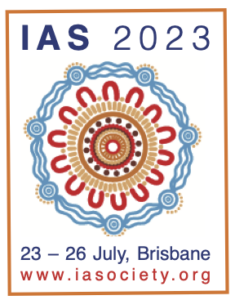IAS 2023: In-utero tenofovir-based PrEP has no effect on children’s bone mineral density
1 October 2023. Related: Conference reports, Pregnancy, Paediatric care, HIV prevention and transmission, IAS 2023 Brisbane.
Polly Clayden, HIV i-Base
 There were no differences in bone mineral density among children of women using and not using tenofovir-based PrEP during pregnancy.
There were no differences in bone mineral density among children of women using and not using tenofovir-based PrEP during pregnancy.
These findings from the PrIMA study (an ongoing evaluation of perinatal PrEP use in Western Kenya) were presented at IAS 2023.
Previous studies found that tenofovir disoproxil fumarate (TDF)-based ART use during pregnancy among women living with HIV may be associated with lower bone mineral density (BMD) in infants.
The SMARTT study found TDF-exposed infants had lower BMD, but no differences in height or weight z-scores, compared with unexposed infants. And the Partners Demo Project found lower z-scores for length at one month but no difference at one year for exposed infants compared to unexposed, but the sample size was small.
Overall there are limited available data on bone outcomes among TDF exposed infants, no study has evaluated bone outcomes beyond infancy, or infants born to HIV-negative women taking TDF-based PrEP.
The aim of this was to evaluate the association between in-utero TDF-based oral PrEP exposure and BMD at 36 months of age.
The investigators used data from mother-child pairs enrolled in PrIMA (PrEP Implementation for Mothers in Antenatal Care). The parent study is a cluster RCT that offered TDF-based PrEP to HIV-negative pregnant women at 20 maternal and child health clinics. Participants were followed through nine months postpartum.
The study includes an extension cohort, PrIMA-X, that is evaluating longer-term infant safety outcomes. This has completed enrollment and is actively following up participants. They are followed until 60 months postpartum.
Birth and growth outcomes are obtained by trained study nurses. About 40% pregnant women in the cohort used PrEP during their pregnancy.
The investigators randomly selected a subset of singleton children aged 36 months with in-utero PrEP exposure. These children were matched (1: 2) to those without in-utero PrEP exposure by: maternal age, education level, and child sex and age.
Whole-body BMD was measured by DEXA scan at Aga Khan University Hospital in Nairobi, Kenya.
A total of 111 children were included in the analysis: 36% PrEP exposed and 64% PrEP unexposed.
The median maternal age at delivery was 28 years and the median duration of PrEP in pregnancy was 12 weeks. The majority of women started PrEP during the 2nd (52%) and 3rd (43%) trimesters.
The median age at DEXA scanning was 37 months. The median height of children at scanning was similar between those with and without PrEP exposure: 94.3 cm vs 94.0 cm, p=0.455.
The median whole-body BMD for children with and without in-utero PrEP exposure was respectively: 418.5 mg/cm2 and 423.0 mg/cm2, p=0.649. The adjusted mean difference was –21.6 mg/cm2, p=0.27.
comment
The investigators concluded that their findings suggest that in-utero PrEP exposure may not affect BMD in early childhood – which would be very good news.
This evaluation is continuing. The next steps include quantifying PrEP exposure during pregnancy using more objective measures such as in hair and dried blood spots. The current analysis is limited by measuring PrEP exposure using self-reported PrEP use.
The study is also currently conducting DEXA scans on the same group of children at 52 months as well as their mothers at both time points.
Reference
Wu L et al. No association between in-utero PrEP exposure and bone mineral density at 36 months of age among mother-infant pairs in Kenya. IAS 2023, 23–26 July 2023, Brisbane, Australia. Oral abstract OAC0402.
https://programme.ias2023.org/Abstract/Abstract/?abstractid=5043 (abstract)
This report was first posted on 25 September 2023.

